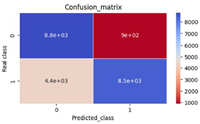On mathematical analysis of the impact of bilinear therapeutic controls with monolytic vaccination for HBV infection model
Abstract
While in acknowledgment of varying existing novel results on control of hepatitis B virus (HBV) dynamic infection, the methodological implementation of bilinear control functions in the presence of designated vaccination has not been explicitly considered. Therefore, the present investigation extending an existing study formulated and redeveloped a 6-dimensional HBV mathematical model that seeks and investigates the mathematical and epidemiological composition of the derived model as well as the methodological behavioral impact of applied bilinear therapeutic control functions and monolytic vaccination. The components of analytic predictions explored differential theory in conjunction with the classical Cauchy-Lipschitz condition. Numerical simulations were conducted using the in-built Runge-Kutta in a Mathcad surface. Results obtained indicated early decline of HBV viral load with intense rejuvenation of the recovered and susceptible state-space, following coherent induced bilinear control functions with designated vaccines. The study is highly recommended for HBV-related cases of co-infectivity.
References
[1]Jannatun N, Chandra NP. A Mathematical study on the vaccination impact on the disease dynamics of HBV. IOSR Journal of Mathematics (IOSR-JM). 2014; 10(6): 26–44.
[2]Atteena PK, Bultery M, Hu DJ, Jamieson DJ. HIV-HBV co-infection–A global challenge. N. Engl J. Med. 2012; 366(19): 1749–1752.
[3]Hagiwara S, Nishida N, Kudo M. Antiviral therapy for chronic hepatitis B: Combination of nucleoside analogs and interferon. World Journal of Hepatology. 2015; 7(23): 2427–2431.
[4]Nasal M. HBV cccDNA: Viral persistence reservoir and key obstacle for a cure of chronic hepatitis B. Gut. 2015; 64: 1972–1984.
[5]AHweiss L, Dandri M. A Review: The Role of cccDNA in HBV Maintenance. Available online: https://www.ncbi.nlm.nih.gov/pmc/articles/PMC5490831/pdf/viruses-09-00156.pdf (accessed on 27 July 2024).
[6]World Health Organization. Key fact on Hepatitis B. Available online: https://www.who.int/news-room/fact-sheets/detail/hepatitis-b (accessed on 27 July 2024).
[7]Alavian SM. Hepatitis B virus infection in Iran: Changing the epidemiology. Iran J clin infect Dis.2010; 5: 51–61.
[8]Bassey EB. Dynamic optimal control model for dual-pair treatment functions of dual delayed HIV-pathogen infections. Journal of Mathematical Sciences: Advances and Applications. 2018; 51(1): 1–50.
[9]Culshaw R, Ruan S, Spiteri RJ. Optimal HIV Treatment by Maximizing Immune Response. Journal of Mathematical Biology. 2004; 48(5): 545–562.
[10]Allali K, Meskaf A, Tridane A. Mathematical modeling of the adaptive immune responses in the early stage of the HBV infection. International Journal of Differential Equations. 2018; 1: 1–13.
[11]Webster GJM, Reignat S, Miani MK, et al. Incubation phase of acute hepatitis B in man: Dynamics of cellular immune mechanisms. Hepatology. 2000; 32(5): 1117–1124.
[12]Bassey BE. Optimal Control Dynamics: Multi-therapies with Dual Immune Response for Treatment of Dual Delayed HIV-HBV Infections. International Journal of Mathematical Sciences and Computing (IJMSC). 2020; 6(2): 18–60.
[13]Manna K, Chakrabarty SP. Combination therapy of pegylated interferon and lamivudine and optimal controls for chronic hepatitis B infection. Int. J. Dynam. Control. 2018; 354–368.
[14]Yousfi N, Hattaf K, Tridane A. Modeling the adaptive immune response in HBV infection. J. Math. Biol. 2011; 63: 933–957.
[15]Dontwi IK, Frempong NK, Wiah EN. Using mathematical model to depict the immune response to Hepatitis B virus infection. American Journal of Sc. & Ind. Res. 2010; 1(3): 516–528.
[16]Medley GF, Lindop NA, Edmunds WJ, Nokes DJ. Hepatitis-B virus endemicity: heterogeneity, catastrophic dynamics and control. Nat Med. 2001; 7(5): 619–624.
[17]Zou L, Zhang W, Ruan S. Modeling the transmission dynamics and control of hepatitis B virus in China; Journal of Theoretical Biology. 2010; 262: 330–338.
[18]Mandell GL, Douglas RG, Bennett JE. Principles and Practice of infectious Diseases. A Wiley Medical Publication John Wiley and Sons; 1979.
[19]Shepard CW, Simard EP, Finelli L, et al. Hepatitis B virus infection: epidemiology and vaccination. Epidemiologic Reviews. 2006; 28: 112–125.
[20]Eikenberry S, Hews S, Nagy JD, Kuang Y. The dynamics of a delay model of hepatitis B virus infection with logistic hepatocyte growth. Mathematical. Biosciences and Engineering. 2009; 6(2): 283–299.
[21]Nancy FC, Mark RW. Vaccination in HIV-infected Adults. Clinical and Epidemiologic Research. 2014; 28(8): 397–410.
[22]Akanni JO, Akinpelu FO. Sensitivity analysis of HIV/AIDS model with vertical transmission, treatment and progression rate. International Journal of Scientific and Engineering Research. 2016; 7(8): 497–514.
[23]Edward S, Nyerere N. A Mathematical Model for the Dynamics of Cholera with Control Measures. Applied and Computational Mathematics. 2015; 4(2): 53–63.
[24]Bassey EB, Adagba OH. Global stability analysis of the role of antiretroviral therapy (ART) abuse in HIV/AIDS treatment dynamics. Pure and Applied Mathematics Journal. 2021; 10(1): 9–31.
[25]Osman S, Makinde OD, Theuri DM. Stability analysis and modeling of listeriosis dynamics in human and animal populations. Global Journal of Pure and Applied Mathematics. 2018; 14(1): 115–138.
[26]Mafuta P, Mushanyu J, Nhawu G. Invariant Region, Endemic Equilibria and Stability Analysis. IOSR Journal of Mathematics. 2014; 10(2): 118–120.
[27]Ezegu NJ, Togbenon HA, Moyo E. Modeling and Analysis of Cholera Dynamics with Vaccination. American Journal of Applied Mathematics and Statistics. 2019; 7: 1–8.
[28]Bassey EB, Igwe OE. On Determinism, Well Posedness and the Application of Cauchy-Lipchitz conditions for a hypo-Hypercovid-19 Epidemic Model. Unicross Journal of Science and Technology. 2022; l1(2): 91–108.
Copyright (c) 2024 Bassey Echeng Bassey

This work is licensed under a Creative Commons Attribution 4.0 International License.











